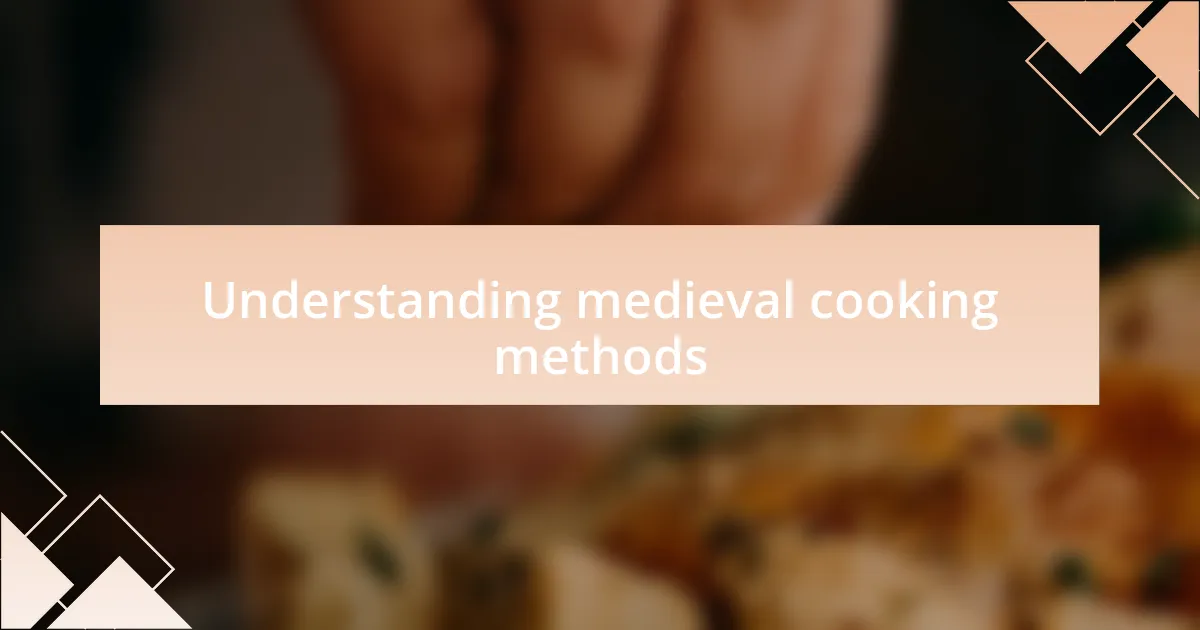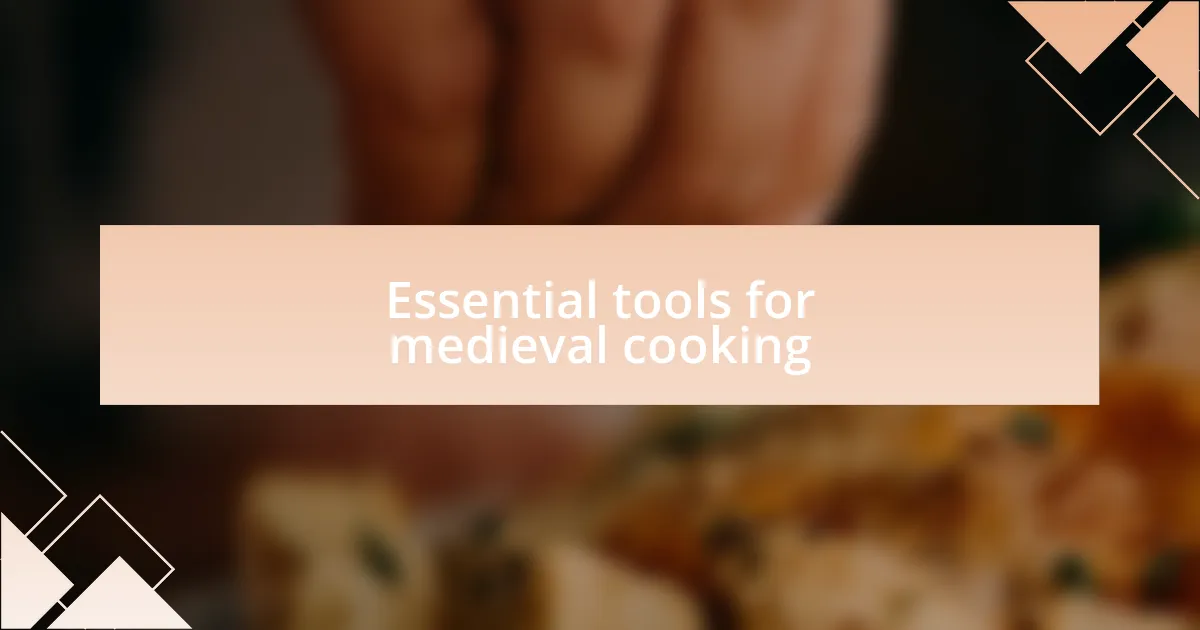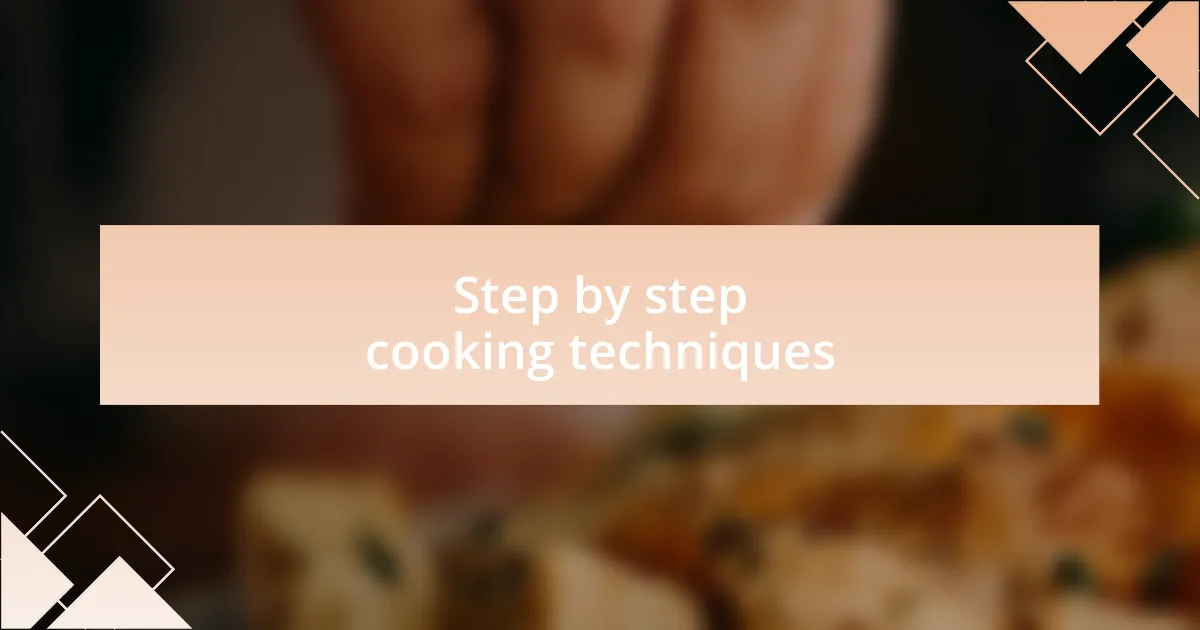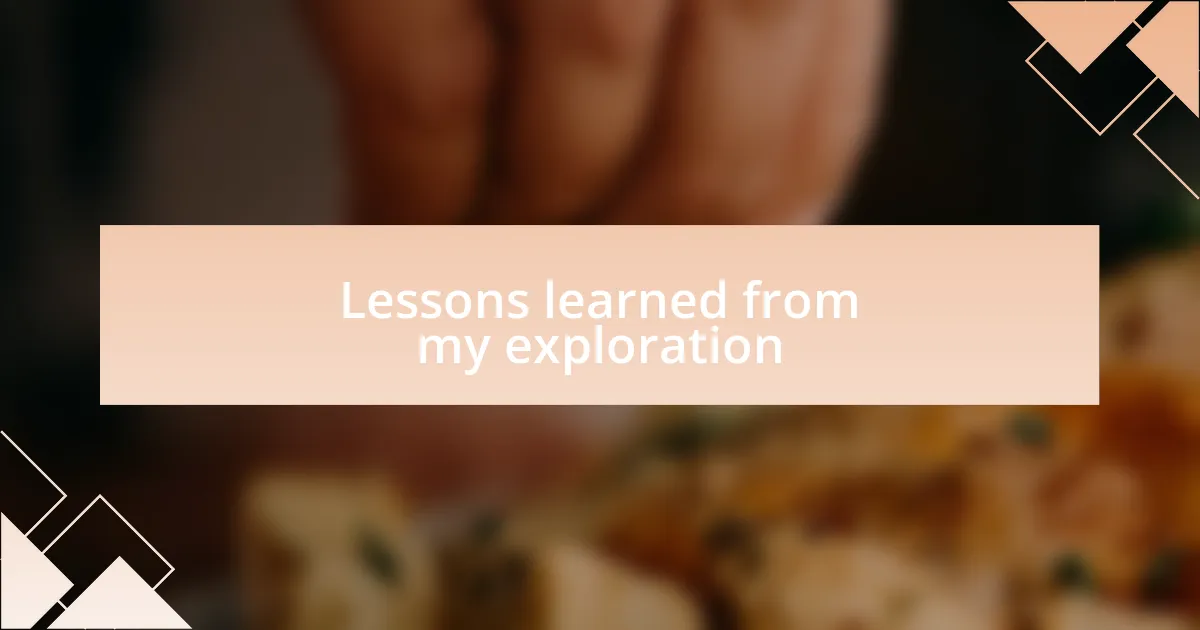Key takeaways:
- Medieval cooking emphasized preservation techniques like salting and drying due to limited refrigeration, highlighting the connection to historical culinary practices.
- Culinary education fosters creativity and community, allowing aspiring chefs to connect with local food traditions and historical methods.
- Key ingredients in medieval cuisine, such as grains and herbs, were essential for nourishment and flavor, showcasing the importance of seasonal and local produce.
- Engaging in historical cooking methods, such as brewing and roasting, deepens appreciation for culinary traditions and the stories behind the food we consume.

Understanding medieval cooking methods
Medieval cooking methods were diverse and often dictated by available resources and societal norms. I remember the first time I tried cooking using a spit over an open flame, just like they did in the Middle Ages. It made me realize how much patience and skill those cooks had to possess—not just for the technique, but for managing the fire to achieve the perfect roast.
One fascinating aspect of medieval cooking is the emphasis on preservation. Techniques like salting and drying were essential, given the limited refrigeration options of the time. While experimenting in my own kitchen, I found that preparing dishes using these methods not only added unique flavors but also connected me to the past. Have you ever tried making your own preserved meats? The process can be labor-intensive, but the satisfaction of creating something that echoes centuries of tradition is truly rewarding.
Additionally, cooking was often a communal activity, bringing people together around the hearth. I vividly recall a gathering where we attempted to recreate a medieval feast, complete with rustic bread and hearty stews. It struck me how much more meaningful cooking can be when shared. Don’t you think that this sense of community is something we sometimes overlook in our fast-paced world?

Importance of culinary education
Culinary education is essential because it lays the foundation for understanding the cultural context of food. I remember sitting in a class where we discussed how regional ingredients influenced medieval cooking. It dawned on me just how vital it is for chefs to connect with local food traditions, as this knowledge shapes their culinary practices and menus today.
Furthermore, learning about historical cooking methods enhances creativity in our contemporary kitchens. During one of my culinary workshops, we experimented with ancient spice blends, and I was amazed at how these time-honored flavors transformed modern dishes. Isn’t it fascinating how we can take inspiration from the past and innovate in our own way?
Finally, culinary education fosters a sense of community and collaboration among aspiring chefs. I still cherish the times spent in the kitchen with classmates, where we learned not only techniques but also shared stories and experiences over simmering pots. Doesn’t it make cooking feel more alive when you’re part of a shared journey toward mastering a craft?

Key ingredients in medieval cuisine
When exploring medieval cuisine, one cannot overlook the significance of key ingredients like grains, herbs, and meats. Bread, often a staple at the table, was primarily made from barley or rye, and I remember the first time I baked a historical bread recipe. The aroma that filled my kitchen transported me back in time, making me appreciate how essential grains were for nourishment and sustenance.
Herbs played a pivotal role in flavoring dishes, with medieval kitchens often stocked with a variety of fresh and dried plants. I spent an afternoon foraging for herbs in my garden, and it struck me how much the right blend could elevate a simple dish into something truly memorable. Imagine the vibrant flavors medieval cooks achieved using seasonal herbs—it’s a reminder of the beauty found in nature’s offerings.
Meat was also central to the medieval diet, with a variety of game and domesticated animals making their way into stews and roasts. I once attended a medieval feast where we enjoyed a game pie, and I was taken by the rich flavors and the story behind that dish. It made me wonder how much of the communal experience of sharing meals stemmed from the labor and love behind each ingredient. Food really does weave together history and culture, doesn’t it?

Essential tools for medieval cooking
When it comes to medieval cooking, having the right tools is essential for authentically recreating those historical flavors. A sturdy cast iron pot was often the backbone of a medieval kitchen, perfect for stews and soups. I remember the excitement of using one for the first time; the way it retained heat reminded me of how resourceful medieval cooks had to be in their craft.
Alongside pots, wooden utensils and platters were ubiquitous in medieval kitchens. These tools not only served practical purposes but also added a rustic charm to the dining experience. I vividly recall my first attempt at serving a dish in a handmade wooden bowl—it felt like a small connection to the past, as if I was sharing a meal with those early culinary pioneers.
Of course, no medieval kitchen would be complete without a hand mill for grinding grains. The rhythmic motion of turning the millstone became almost meditative for me during my cooking experiments. Have you ever wondered how much effort went into creating the flour for those delicious breads? Realizing the hard work behind each ingredient truly deepens my appreciation for the meals we often take for granted.

Step by step cooking techniques
When exploring step-by-step cooking techniques from the medieval period, I found a fascinating rhythm to the process. For instance, while simmering a hearty stew, I learned the importance of layering flavors by first browning the meat. I still remember the aroma wafting through my kitchen—it transported me to a time when every ingredient was valued for its contribution to the final dish. Have you ever taken a moment to truly appreciate how that initial browning sets the stage for a meal that nourishes both body and spirit?
Next, let’s talk about baking methods that left a mark in culinary history. I distinctly remember my surprise at how different it felt to prepare bread using a simple hearth. The flames danced around the loaves, creating a crust that was unlike anything I’d experienced. Did you know that medieval bakers often used a practice called “proofing” the dough in front of the fire? It’s a great reminder that, even in early kitchens, patience was a key ingredient in achieving the perfect rise.
Continuing with preservation techniques, I was struck by the variety of ways medieval cooks would extend the life of their ingredients. While experimenting with pickling vegetables, I discovered how vinegar transforms flavors and introduces a delightful tang. This simple method opened my eyes to the connection between cooking and ingenuity, prompting me to wonder: how many generations have relied on these techniques to sustain themselves through harsh winters? Engaging with these methods deepens my respect for the culinary heritage that we continue to build upon today.

Personal experiences in medieval cooking
As I delved into the art of medieval cooking, one experience that stands out was my attempt at spit-roasting a whole chicken. The process was both exhilarating and daunting, standing vigil by the open flame while carefully turning the meat. I felt a profound connection to those ancient cooks, each rotation a reminder that patience and attention were essential ingredients every bit as vital as the spices used.
Another memorable moment was when I began brewing my own ale, a staple in the medieval diet. The sweet scent of malted barley filled my kitchen, mingling with hopes of capturing that taste of history. Did I manage to recreate the rich flavors of yesteryear? Not quite—but the laughter shared with friends as we sampled my less-than-perfect brews reminded me: in cooking, it’s often the moments of togetherness that truly matter.
Exploring cooking methods like roasting and brewing immersed me in a sensory experience that transcended mere cooking. I remember feeling an overwhelming sense of pride as I displayed my homemade dishes at a local gathering, sparking conversations filled with curiosity about culinary traditions. It made me wonder: how many stories are woven into the flavors we often take for granted? Engaging with these historical techniques has deepened my appreciation for the rich tapestry of flavors and experiences that shape our culinary landscape.

Lessons learned from my exploration
As I experimented with the aging process for cheeses, I learned that time is a crucial ingredient. I vividly recall the anticipation that built over weeks as I watched the wheels develop their flavors. It struck me how much trust the process demands; aging food is about patience and letting nature take its course. Have you ever felt that thrill of watching something transform over time?
Creating my own medieval-style bread presented another lesson: simplicity can be incredibly rewarding. The first time I mixed flour, water, and a pinch of salt, I was amazed at how those humble ingredients could yield such a delightful aroma and texture. There’s something special about kneading dough by hand that connects you to generations of bakers before us. It raised a question in my mind: how often do we overlook the beauty of simple pleasures in our modern culinary pursuits?
Throughout my exploration, I discovered that each method holds stories waiting to be told. While attempting to pickle herbs using ancient techniques, I felt a sense of continuity with the past. It was not solely about preservation; it was an act of honoring traditions that have been shared across centuries. Reflecting on this, I realized: what better way to pay homage to our culinary heritage than by embracing the lessons hidden within these age-old methods?